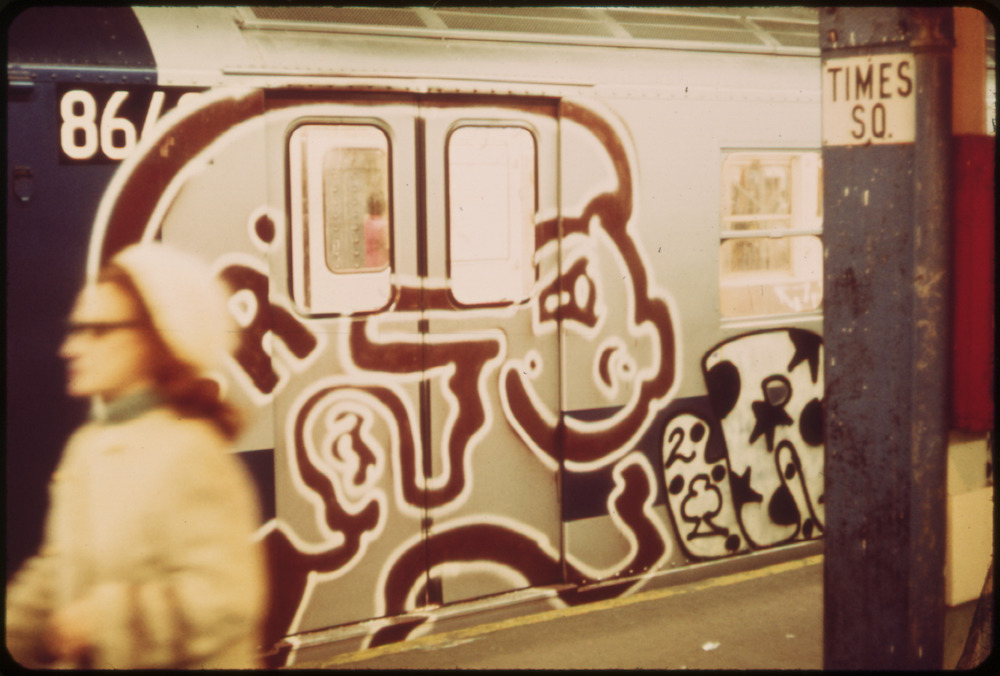RIFF 170 expanding the boundaries of what piecing could be in 1973. 📷: Erik Calonius
“Everything is connected to everything else. Urban clutter is connected to air pollution, to noise, to foul water. Agri-business is connected to the use of pesticides. Lifestyles are connected to solid wastes. And, so on.” Those were the guidelines the Environmental Protection Agency (EPA) provided to over 100 freelance photographers that they hired in the early 1970s as part of its “Documerica Project.” The group fanned out across America to “record the state of the environment and efforts to improve it” in both urban centers and rural areas alike. One of those shooters was Erik Calonius. In 1973, he was assigned with giving the federal agency a snapshot of New York City’s transit system and he delivered. He may have also unwittingly created one of the most important visual bodies of work surrounding the rise of subway graffiti.
One of the great things about New York is that it seemingly changes with each generation, but in the early 1970’s, the shift was relatively momentous, as the city tried to distance itself from the past, and project itself as a more modern metropolis. This visual shift in the city happened to align itself with a visual shift on the city’s subways, as the graffiti movement was about to make the leap from single hits to masterpieces, which would become its bread and butter. When photographs of this era surface, it’s always worth going over them with a magnifying glass to see what we can unearth.

The modern day writing movement had sprung up in the city in the late 1960s, with the invention of the Magic Marker, and the ubiquitous supplying of spray paint into local hardware stores. It was an urban competition that revolved around friends having fun, and seeing who could get their name around the most. In 1969 the graffiti began to seep into the Transit system, and by 1971 the first tags began appearing on the outsides of trains.

In the photo of the subway tiles at 103rd Street, you get a feel for what the expectations and limits of the first generation were, names are everywhere, written in various styles and mediums. The layers are so dense that the only name that stands out is the local writer SKY 1. Writers did everything in their power to draw attention to their names, from using arrows, to clouds, to adding a crown to show king status. This need for attention would finally give way to the masterpiece – an elaborate work done in spray paint – that would separate itself from the surrounding tags.

In late 1972, the writing movement mirrored the city in its complex changes, as single hits gave way to masterpieces, laying a foundation for generations to follow. Many of the early wall writers gave up, what was once a fun thing to do with your friends was now turning into a chore, involving the racking of too much spray paint, others had just aged out. On one of the exteriors of the trains you’ll notice a simple SPY 161 signature piece, this was CAY 161’s backup name, and was done right at the tail end of his career. The obverse of that can be viewed in the portrait of the African American woman, who just happens to be sitting in front of one of MOSES 147’s first tags. In 1973, MOSES would be at the height of his powers, and was dubbed the King of the 1 Line. You have in these images, the passing of the baton from the early tagging generation, to the newer piecing generation.

The images also provide insight into old New York. At the 125th Street station you have a passenger looking out over a smog filled Harlem sky where incinerators are belching ghastly smoke into the clouds. Incinerators held such promise for a city looking to dispose of its trash, which had risen dramatically in the post-war boom. Despite the ashes and smoke, we clung to them until the early 1970s, when the pollution became too great, and the city moved on to compactors. In the photo below, we are given a wonderful glimpse of a candy machine, one of many that had proliferated throughout the subway system. There were also soda machines, vending machines with pocket combs, horoscopes, and even scales to weigh yourself. By 1973, they were barely making money, and the following year, the city removed them all.

The subway trains themselves had also gone through an overhaul, painted silver with a dazzling blue stripe that ran across the side of the car, city buses were also painted the same way. Both buses and police cars had originally been painted green, by 1973 they would become blue and white like the subways. All of these things had been in play for forty years, red trains, green buses, green cop cars, vending machines, and incinerators. You didn’t think about them, they were just part of life, until, in a two year span they were gone. In that same two year span, graffiti had become a mainstay in the city’s subway system. The rest is history.





Follow Chris FREEDOM Pape on Instagram.






